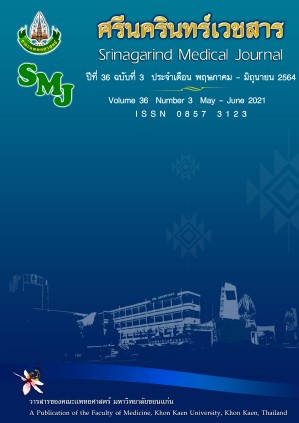ปัจจัยที่มีความสัมพันธ์กับการใช้สื่อสังคมออนไลน์ในผู้ป่วยมะเร็งเต้านมที่ได้รับยาเคมีบำบัด
Abstract
หลักการและวัตถุประสงค์: มะเร็งเต้านมเป็นสาเหตุการเสียชีวิตอันดับ 5 ของมะเร็งทุกชนิดในหญิงไทย การรักษามะเร็งเต้านมอาจมีผลข้างเคียงกับผู้ป่วย เช่น ผมร่วง แผลในปาก คลื่นไส้ ท้องเสีย และเบื่ออาหาร เป็นต้น ผู้ป่วยใช้สื่อสังคมออนไลน์เพื่อค้นหาข้อมูลสุขภาพที่เกี่ยวข้องกับการรักษาของตนเอง การศึกษานี้มีวัตถุประสงค์เพื่อศึกษาปัจจัยที่มีความสัมพันธ์กับการใช้สื่อออนไลน์ในผู้ป่วยมะเร็งเต้านมที่ได้รับยาเคมีบำบัด
วิธีการศึกษา: เป็นการศึกษาเชิงพรรณนาแบบภาคตัดขวางกับผู้ป่วยมะเร็งเต้านมที่โรงพยาบาลมะเร็งอุบลราชธานี จังหวัดอุบลราชธานีในช่วงเดือนเมษายน-ธันวาคม 2562 เก็บข้อมูลโดยใช้แบบสอบถามทางประชากร เป็นแบบสอบถามการใช้สื่อออนไลน์ และแบบสอบถามคุณภาพชีวิต วิเคราะห์ข้อมูลด้วยโปรแกรมสำเร็จรูปทางสถิติ เพื่อนำเสนอสถิติเชิงพรรณนาและสถิติเชิงอนุมาน
ผลการศึกษา: ผู้ป่วยมะเร็งเต้านมจำนวน 204 ราย ร้อยละ 43.63 เคยใช้สื่อสังคมออนไลน์ ปัจจัยที่มีความสัมพันธ์อย่างมีนัยสำคัญกับการใช้สื่อออนไลน์ในผู้ป่วยมะเร็งเต้านมได้แก่ อายุผู้ป่วย 60 ปีขึ้นไป การศึกษาระดับมัธยมศึกษา และอาชีพ (p<0.05)
สรุป: อายุ ระดับการศึกษา และอาชีพมีความสัมพันธ์กับการใช้สื่อสังคมออนไลน์ในผู้ป่วยมะเร็งเต้านม ดังนั้นหน่วยงานด้านสุขภาพควรนำปัจจัยอายุ การศึกษา และอาชีพมาพิจารณาในการให้ข้อมูลมะเร็งเต้านมผ่านสื่อสังคมออนไลน์ที่ได้รับความนิยมในกลุ่มผู้ป่วยมะเร็งเต้านม เนื่องจากเข้าใจง่ายตรงความต้องการของผู้ป่วย
คำสำคัญ: ปัจจัย; สื่อสังคมออนไลน์; มะเร็งเต้านม; เคมีบำบัด
Background and Objectives: Breast cancer is the fifth most common cause of death from cancer among women around the world. Breast cancer treatments may have many side effects in patients, such as hair loss, mouth sore, nausea, diarrhea and loss of appetite. The patients used online social media for searching the health information concerning their treatment. This study aimed to investigate the factors associated with online social media (OSM) used in breast-cancer patients (BP) receiving chemotherapy.
Methods: A cross-sectional study was conducted among breast-cancer patients receiving chemotherapy at Ubon Ratchathani Cancer Hospital, Ubon Ratchathani province during the period April to December 2019. Data were collected by questionnaires comprising socio-demographic characteristics, online social media usage behavior and an instrument to measure health-related quality of life. The obtained data were analyzed using descriptive and analytic statistics with a computerized statistical package.
Result: A total of 204 BP participated in the study; 43.63% had ever used online social media. The factors which were significantly related to OSM among BP included: patients over 60 years of age, secondary education level and occupation (p<0.05).
Conclusion: Age, education level and occupation represent relate to online social media for breast-cancer patients. Therefore, health services authority should be taken the factors of age, education, and occupation to consider in providing information about breast cancer through the OSM, which are popular among breast-cancer patients, easy-to-understand information to meet the needs of patients.
Keyword: Factors; online social media used; breast cancer; chemotherapy


